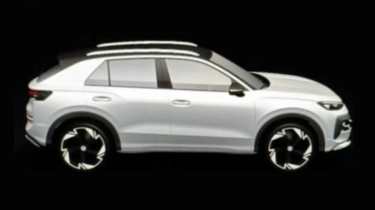The second generation of the hugely popular Volkswagen T-Roc will be revealed in August, the brand’s CEO has confirmed, and is set to be the first VW to feature new full-hybrid technology that’ll eventually make its way into the Golf and Tiguan as well.
The first images of the all-new T-Roc were leaked online in January and shared on the Instagram account rollendereporter. From what we can tell, they are snapshots of the infotainment system’s settings menus showing the new car’s much more aggressive design.
The wide-mouthed front end that looks like it could bite your arm off has a clear resemblance to the latest Volkswagen Tiguan, Tayron, Golf and Passat, although to our eyes there is also some similarity with the new MG3 and MG HS SUV.
Looking beyond the sizable grille and prominent air intakes on either side, we can see a slim set of LED headlights connected by a thin strip – just like the other, aforementioned VWs – while the rear features a larger lightbar. The new model also carries forward the current T-Roc’s rakish roofline and sloped rear window.
We asked Volkswagen CEO Thomas Schäfer whether the brand’s design boss Andreas Mindt – who took on the role in 2023 – had had a chance to shape the new T-Roc since his arrival. He told Auto Express: “I’d say about 50 per cent. We changed a few things in the front, the back and the interior, definitely. The car was in a good space, much better than some of the previous ones, so there was no need to redo the car completely.”


Schäfer added that dealers have already seen the new T-Roc, and much more besides: “We showed them all the cars from now until 2028 and they were blown away. The feedback was phenomenal, like wow. We also gave them an indication of price and all of this gave dealers a lot of confidence.”
Volkswagen’s new hybrid technology
Full-hybrid cars – or self-charging hybrids, as Toyota calls them – use a combination of a petrol engine and an electric motor. This type of set-up allows for pure-electric driving, mostly around town at lower speeds, or has the two power sources working together to maximise efficiency. But most importantly for some drivers, the cars don’t need to be plugged in anywhere to charge their battery.
